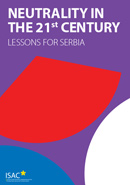Austria´s “Permanent Neutrality” after 1955 – a Model for Serbia?
Austria´s “Permanent Neutrality” after 1955 – a Model for Serbia?
Author(s): Friedhelm Frischenschlager
Subject(s): Politics / Political Sciences, Politics, International relations/trade, Peace and Conflict Studies
Published by: ISAC - Centar za međunarodne i bezbednosne poslove
Keywords: Austria; Serbia; Permanent Neutrality; international relations
Summary/Abstract: Austria´s permanent neutrality is a very specific case of neutrality, quite different from the other examples of neutrality introduced at this conference. Its origin, substance and political weight are linked mainly to the international developments after 1945 at European and global level and the Austrian reaction to them. Accordingly it has undergone some changes since its adoption in 1955. Formally Austria never abandoned permanent neutrality, today more for domestic reasons, as Austrian citizens grew extremely emotionally attached to it. Could Austria’s permanent neutrality serve as a model for Serbia? From the “original” Austrian permanent neutrality – as a product of the Cold War – more or less nothing is of relevance for a European state of today. Austria itself faces some difficulties with its permanent neutrality and tries to pass by “new interpretations”. But, how Austria dealt with its neutral status when approaching EU, the role it played for the EU in the accession process and today for Austria as an EU member state in a Union with a Common Security and Defence Policy, these experiences provide some interesting aspects, may well be relevant for Serbia’s EU accession process.
Book: NEUTRALITY IN THE 21st CENTURY –LESSONS FOR SERBIA - ESSAY COMPENDIUM -
- Page Range: 59-66
- Page Count: 8
- Publication Year: 2013
- Language: English
- Content File-PDF

